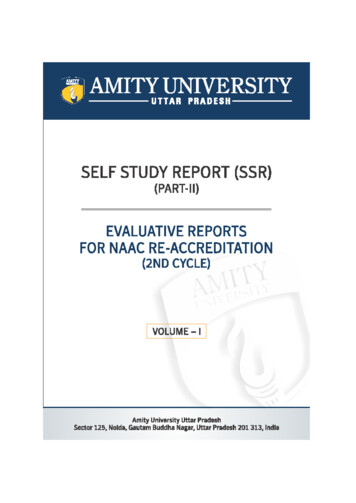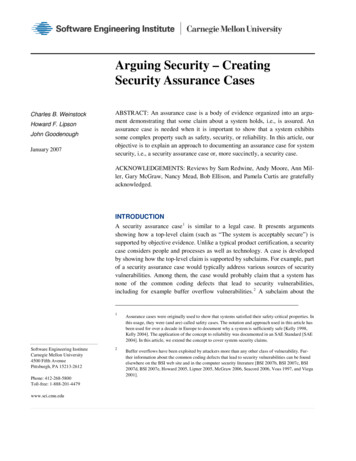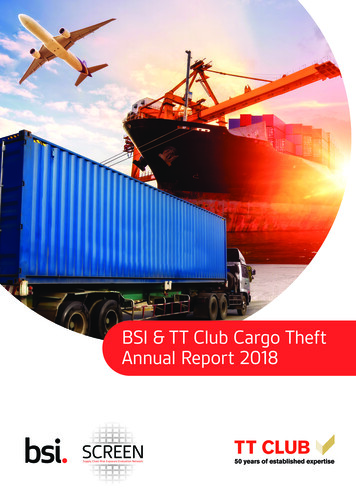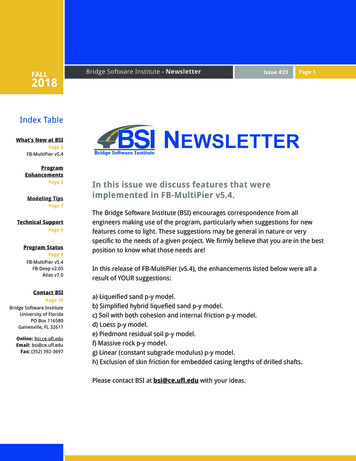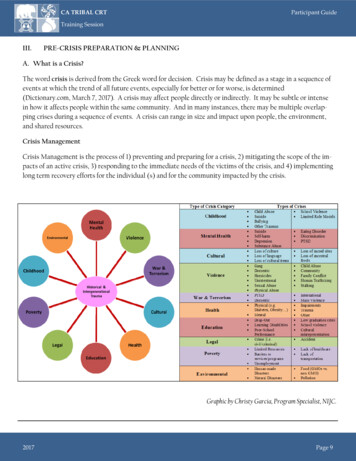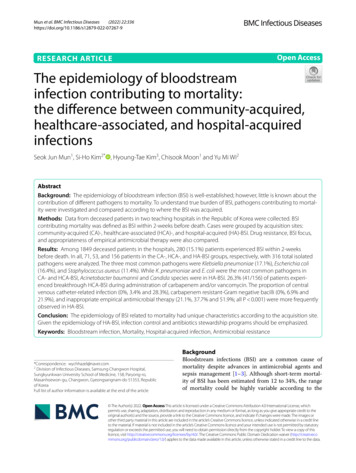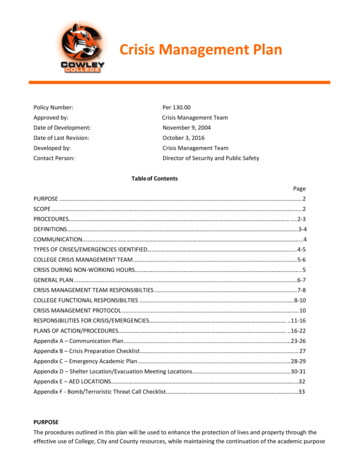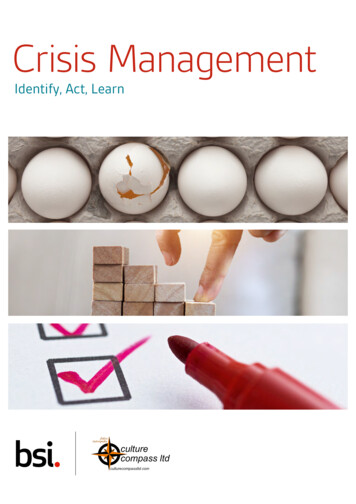
Transcription
Crisis ManagementIdentify, Act, Learn
Crisis Management – Identify, Act, LearnResilience in times of change and crisisThe ability to thrive when facing either opportunity or adversity is a test that many food sectororganizations find challenging. With competing priorities and an ever-shifting landscape of consumerdemands, business continuity may not be a key focus. However, when approached from a holistic riskmanagement perspective, business continuity can help organizations identify where crises may occur aswell as ensure people and processes are in place to manage them competently and consistently.Whether it’s caused by a new process, raw material,equipment or even personnel, change is when foodmanufacturers are most vulnerable to issues, mistakes andfailures. When contemplating or implementing changes,conscious consideration of their impact can help reduce theprobability of an incident or crisis.However, no matter how careful an organization’s approachto change is, not all risks can be pre-determined andproblems can occur. Whether issues are small or significant,having an established way of managing them can make thedifference between resilience and simply surviving.Teams and trainingOrganizations seeking a resilient approach to crisis management need appropriate resources in place. While the teamsfrom the part of the business where the crisis originated should be involved in the process, they are likely not skilled in crisismanagement. This activity isn’t necessarily best-placed with management either, there needs to be a trained core team thatworks together to navigate the organization to calmer waters. Crisis management doesn’t necessarily requirefull-time roles, but an effective crisis team includes members who: Are competent, trained and have the availabilityto participate in mock exercises up to ten timesa year Have reasonably agile jobs so that when needed,they can be released from their day-to-day roles tomanage crises when they arise Can access required materials/resources and areempowered with the authority to draw on criticalexpertise across the business Are authorized to make decisions based on soundtechnical and business information managementmay ratify the decisions, but not withoutsubstantial reasoningCritical to the successful management of crises isthat decisions aren’t made and actions aren’t takenwithout the consultation or approval of the crisismanagement team. This works to ensure that, becauseof their crisis management training, decisions are madewith reflection on the wider implications that othercontributors may not consider.2
Crisis Management – Identify, Act, LearnIdentifying vulnerabilitiesAssessing processes from a risk perspective and determiningappropriate and proportionate mitigation controls canprovide means of measurement that can drive culturalengagement and improvement. Understanding where issuesare likely to originate, exploring those vulnerable points anddeveloping strategies to manage them before they becomeissues are similar to the advice that an ounce of prevention isworth a pound of cure.Change as a vulnerability has been addressed, some otherpossibilities are listed to the right; but organizations may alsohave ones unique to their situation. Raw material supply (e.g. crop failure,administration, equipment failure) Manufacturing and supply chain issues Epidemic, pandemic, industrial action, lossof services Geopolitical events (e.g. Brexit, regime change,legislation change) Protestation, NGO targeting, social mediaevent, etc.Event or conditionA condition is a gradual occurrence which only becomesevident at a point far beyond the start of the occurrence.These are categorized as a gradual deterioration over time,where the impact or concern is having an effect before theissue is detectable.Understanding the difference between an incident broughtabout by an event and an incident brought about bya deteriorating condition is vital to ensuring the rightapplication of resources in the right areas of investigation.The situation, investigation, conclusions and decisions aredifferent for each one.Conditions require a judgement, based on the informationavailable, as to when to draw a line and assume a defectiveproduct or situation is contained. Examples include:An event is a singular occurrence, that can be identifiedto a certain point in time. These are characterized by theability to pinpoint or accurately estimate their timing, so allproduct and materials before that time are regarded as ‘safe’.Examples include: Growth of microorganisms or chemicaldecomposition in product Slow gradual leak of materials into theproduction stream Wearing of equipment over time, whichcontaminates the product Delivery of material Failure of equipment Cross-contamination or end of material shelf life Change of process, material, team, etc. Build-up of infestation Product launch/introduction Deterioration of quality over time3
Crisis versus incidentThe significance of an unexpected event should determinehow it’s managed. Identifying the difference between whatmarks an incident and what qualifies as a crisis is critical.BS 11200:2014 Crisis management – Guidance and goodpractice, provides working definitions:Incident: an adverse event that might cause disruption, lossor emergency, but which does not meet the organization’scriteria for, or definition of, a crisis.Crisis: an abnormal and unstable situation that threatens theorganization’s strategic objectives, reputation or viability.It’s important to have escalation criteria, clearly definingwhen a situation should flip from an incident to a crisis, andunderstand the difference. If this isn’t done appropriatelyorganizations risk: Misinterpreting or under-investing in a situation,potentially leading to more serious circumstances Applying resources disproportionately (e.g. seniorleaders managing incidents or junior managersleading crises) Applying resources inappropriately where the wrongskillsets and authority are charged with resolvingthe problem Regulatory non-compliance Damaged customer relationships and brandOrganizations with a clear risk and escalation matrix andsupporting processes are positioned for resilience; todeliver a stronger business, that can foster closer customerand regulatory relationships as well as richer consumerconfidence and loyalty.Escalation matrixDeveloping an escalation matrix can be an effective wayof determining the level of escalation needed and reduceconfusion when every minute matters. The complexity ofthe matrix depends on a number of factors including sizeof business (number of site and staff), number of productsmade, depth of supply chain, production volumes and more.The next step will be to consider threats. The challenge hereis not to be too specific or too broad as either can lead toconfusion. But the key is to think about all aspects of theorganization: product, people, process as well as externalparties. Using an environmental issue as an example, if thelist included every potential type of problem (e.g. incorrectdisposal of waste, chemical leak, fuel spill, etc.), whenextended to include other non-environmental threats theescalation matrix becomes too complex. Unless the teamsmanaging and reacting to these would be different, as shownin Figure 1, it makes sense and provides clarity to group theminto one threat of ‘environmental’ and use the escalationindicators of: local, contained event; multiple events with localexposure; prosecution and media risk; and cancellation as youmove across the matrix from minor to significant.Escalation levels can be coded by number, colour orsomething that makes specific reference to an organization’sculture. Whatever the choice, keep it simple so it can beeasily recalled when stress levels are high. For each level,determine which teams need to be involved or aware, and,possibly, external parties (e.g. regulatory, consumers, nearbybusinesses or residents). As the number of levels of escalationshouldn’t be numerous, assigning these across the top of thematrix, running left to right is likely practical. Which teamsand external parties need to be involved can be in the samecell, or they can be listed in the first rows for clarity.Escalation matrix (Figure 1)Level oneLevel twoLevel threeLevel fourLead management team:Site teamRegional, divisional,functionalBusiness, groupGroup, regulatory,insurersCommunicate to:Site staffRegion, divisionBusiness, regulatory,customerGroup, regulatory,authority, industryEscalation and support:AdvisoryBusinessBusinessIndustry, country,governing bodyLocal, containedeventMultiple events, localexposureProsecution,media riskRemoval ofoperating permitEnvironmental:4
bsigroup.comData-driven decision makingMapping out the event timeline and overlaying production,deliveries, complaints, laboratory results turns various piecesof data into a clear picture of the event. This can help notonly identify the source or pattern, it may also support themost effective route to a resolution.During a crisis, the quality of decisions made relies on thestrength of the information available. Good data relies ontimely and accurate responses from those holding criticalroles. However, even when all of these pieces of informationare available, if they’re used in isolation, the lack of contextcan prolong and/or extend a crisis.Reflect, review, follow upCarefully considering the issue(s) that created the crisisand all the aspects that were impacted as it was managedprovides the ideal time to identify how an organization canbecome more resilient.The process following an incident is as critical as managingthe incident itself. Pushing through to the end whereproduction, staff and external stakeholders are satisfied isnot enough. The days following a crisis can be an opportunityfor organizations to learn more about: Gaps that can be closed Processes that can be improved or need to bedeveloped and implemented Weaknesses in food safety culture Supply chain vulnerabilities5
Crisis Management – Identify, Act, LearnWhy BSI?BSI believes the world deserves safe, sustainable and socially responsible food. We offer a broad rangeof certification and risk management services to help organizations in the food and retail supply chainmitigate risk, protect their brands and build resilient supply chains.With 90 offices around the world, we are a leading food safety and certification provider with the capacityand capability to provide integrated services for a wide range of food safety and business improvementstandards across the entire food and retail supply chain; including GFSI-recognized standards.Our products and servicesKnowledgeAssuranceComplianceThe core of our business centres onthe knowledge that we create andimpart to our clients.In the standards arena we continueto build our reputation as an expertbody, bringing together experts fromindustry to shape standards at local,regional and international levels.Independent assessment of theconformity of a process or productto a particular standard ensures thatour clients perform to a high levelof excellence. We train our clientsin world-class implementation andauditing techniques to ensure theymaximize the benefits of standards.To experience real, long-term benefits,our clients need to ensure ongoingcompliance to a regulation, marketneed or standard so that it becomesan embedded habit. We provide arange of services and differentiatedmanagement tools which helpfacilitate this process.For more information onimproving your organization’sfood safety culture,visit bsigroup.com/en-HK oremail hk@bsigroup.com6
Crisis management doesn't necessarily require full-time roles, but an effective crisis team includes members who: Are competent, trained and have the availability to participate in mock exercises up to ten times a year of their crisis management training, decisions are made Have reasonably agile jobs so that when needed,
